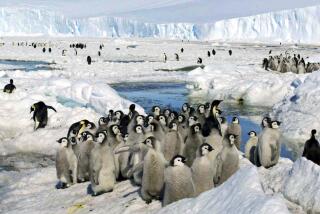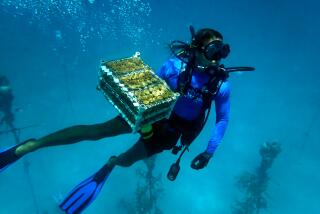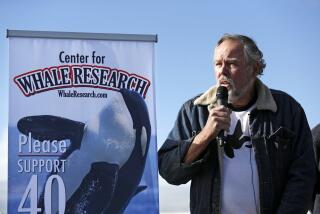Off to Biology’s Icy Mecca : Science: An Orange Coast College marine researcher is headed for Antarctica. For him, it’s ‘like winning the lottery.’
COSTA MESA — For Orange Coast College marine biologist Dennis L. Kelly, it’s a childhood dream come true, a chance to walk in the footsteps of the first explorers of the South Pole.
Kelly, known for his research on bottlenose dolphins off the county coast, will join a four-week scientific expedition in February to study the ecosystems of Antarctic marine life.
And students at Orange Coast, home of the largest marine science program at any community college in the nation, will benefit from his adventure through photographs and lectures he plans to develop along the way.
“For a marine biologist, it’s like winning the lottery!” said the sandy-haired professor who still talks animatedly about movies he saw as youngster about the exploits of British explorers Robert F. Scott and Ernest Shackleton, who sought the South Pole in the early 1900s.
“It’s like an impossible dream,” said Kelly, 43, of Corona del Mar. “I never thought I’d be able to get permission to go. . . . Even now, there’s still a part of me that says the plane won’t start.”
The expedition is the fourth annual Antarctic Ecosystem Research Group project to study a 150-square-mile region off the Antarctic Peninsula, the northernmost finger of land on the world’s fifth-largest continent.
The $1.3-million-a-year project is run by the Southwest Fisheries Science Center in La Jolla. Data collected is used partly to advise congressional leaders and U.S. and international policy-makers about optimum levels for commercial fishing in the area that will not harm wildlife or the environment.
A second goal, scientists say, is to learn more about a strange and mysterious continent whose interior is barren but whose shores teem each summer with three-fourths of the world’s fur seals, most of the world’s penguin population, six species of filter-feeding whales and mammoth swarms of krill.
“It’s very exciting because there’s a lot we don’t know about the Antarctic,” said Roger Hewitt, leader of the ecological study group and a fisheries center biologist. “For me, it’s an opportunity to go into an area and try to figure out what’s going on before it has been raped and plundered.”
Kelly, in essence, will act as a research assistant to two experts on shrimplike creatures called krill, a major link in the delicate food chain of the Antarctic.
He will leave Orange County on Valentine’s Day, arriving Feb. 15 in the Chilean port city of Punta Arenas in the Strait of Magellan near the southernmost point of South America, Cape Horn. “I get to fly over the Amazon rain forest and the Andes!” he interjected, brimming with characteristic enthusiasm.
On Feb. 18, he and 24 other scientists and 71 crew members will depart aboard the Surveyor, a 290-foot research vessel owned by the National Oceanic and Atmospheric Administration, of which the Southwest Fisheries Science Center is a branch.
From Punta Arenas, the ship will steam for three days across Drake Passage, the 400-mile body of water between Cape Horn and the South Shetland Islands, to the study area, which is centered on Elephant Island, one of the South Shetlands near the tip of the Antarctic Peninsula.
First stop will be Seal Island, a 10-acre clump of rocks just north of Elephant Island that is covered with more than 40,000 penguins, 500 fur seals, lolling elephant seals and assorted sea birds such as skuas and petrels.
The Surveyor’s crew will drop off provisions for scientists who will have been living in a collapsible, insulated hut since early this month, counting Seal Island’s penguins, seals and their young and monitoring their feeding and breeding behavior.
Next the researchers will head for open water around Elephant and Seal islands, where they will sample currents for speed, depth and direction, and the water for salinity and oxygen levels. They will also take samples from the ocean floor and use sonar to map the bottom.
On this leg, Kelly will work for two krill experts from Moss Landing Marine Laboratories north of Monterey. Their team will capture krill in fine nylon mesh known as a “bongo net.” These Antarctic krill, much larger at 2 to 3 inches long than those found elsewhere in the world, will be examined for, among other things, their size, sex and number of eggs borne by the females.
Researchers will also use sonar to determine the depth of the swarms of krill found throughout the area.
“They’ve seen super swarms of krill off the peninsula that are 200 feet deep, a mile wide and 15 miles long,” Kelly said. “And the krill, themselves, are (swimming) an inch apart. You’re talking maybe 50,000 to 75,000 tons of krill, and there are several of these super swarms all around the continent.”
Paging through research material in his Costa Mesa office, Kelly shook his head in wonder. “How does so much life end up in a place that is so barren?” he asked.
“Summer there only lasts three months, and during that three months, the most incredible plankton bloom in the world occurs. . . . It’s roughly equivalent to the red tide blooms you see off our coast during some months in the summer, but hundreds, thousands of times greater. Down in the Antarctic, the ocean is green with plankton.”
Research to date has led to a cap on krill harvesting at no more than 1.5 million metric tons a year in the waters north and west of Antarctica, Hewitt said. That is three times the average annual take of 400,000 to 500,000 tons, mostly by the Japanese fishing industry, which turns krill into paste and other high-protein byproducts.
Another aspect of the study is the effect of ultraviolet radiation on light-sensitive plankton. Kelly said this is of special concern in a region where the atmospheric ozone layer, a shield against damaging ultraviolet rays, develops a hole above Antarctica each year from December through February.
Hewitt said the impact of damage to the Earth’s ozone layer is only an indirect aspect of the research project. Still, tests of plankton brought from Antarctica and subjected to ultraviolet radiation as the ship heads north indicate that the algae-like material will stop growing and not reproduce when subjected to significant amounts of radiation.
What Kelly and many other environmentalists fear is that the tear in the Antarctic ozone layer may impair the plankton bloom and thereby reduce food available for krill, and in turn the birds and mammals.
Project researchers have already documented a decline in the number of young penguins and seals early in the breeding season last year, probably associated with a later-than-normal appearance of krill swarms, Hewitt said. But the breeding picked up later, once the krill turned up.
“Now, is this a normal fluctuation, or is it the beginning of the end?” Kelly asked. “Are we going to see a complete and horrific change in the ecosystem (because of damage to the ozone layer)? Or is this something we’re going to laugh about 100 years from now?”
Kelly’s good fortune is also a deal for the Antarctic Ecosystem Research Group. The team depends on volunteers, because its annual congressional allotment is just a quarter of what it would cost to pay everyone. Lots of graduate students are eager to get such a plum research project on their resumes, but experienced hands are needed.
“We always need help, particularly from people who have been to sea before and know how to handle our sampling gear, and Dennis had done that,” Hewitt said.
The research project agreed to pay Kelly’s Los Angeles-to-Chile air fares, $2,500 worth.
Kelly needed permission to leave for a month during spring semester. Even his bride of two months agreed. But getting substitutes to take over his six classes--that, he was sure, would not happen.
Eventually, through the intercession of Orange Coast College President David A. Grant--a mariner who used to run the college’s extensive sailing program--the Coast Community College District’s trustees agreed to pay for substitutes to cover Kelly’s classes for a month.
“I’m really grateful to my dean, James Fitzgerald, and to our president, Dave Grant,” Kelly said. “They worked really hard to make this happen.”
But the college and Kelly’s students also stand to benefit. Ever the teacher trying to turn young minds on to science, Kelly plans to take photographs and develop lectures on his Antarctic work. He will take a high-resolution video camera to record the ice-covered peninsula and its creatures, and also the research.
“I want to show them what it’s like,” he said, “to be part of a real scientific expedition. . . . I’m going to be working my butt off. I’m scheduled for two watches a day of five hours each. . . . Orange Coast is going to get an incredible amount of bang for their buck.”
Kelly even plans to talk about his experiences as part of OCC’s “armchair explorer” series of non-credit courses for the general public.
Kelly knows the expedition will not be easy. Temperatures will range from 20 degrees to nearly 40 degrees Fahrenheit, but wind chill can be considerable.
Hewitt, who will be making his sixth trip to Antarctica next month, said: “I can’t emphasize enough how boring these trips are. Yes, the scenery is spectacular. You never see one whale, you always see a pod of them, and you never see just a few penguins, you see thousands. . . . That part is exciting.
“But to make a successful cruise happen, you need to get into a pattern. . . . It’s a little bit odd to go to bed while it’s light and get up when it’s still light out. Little things like taking measurements at the same time every day become very important marks of time. Meals become very important.”
For the researchers who stay on Seal Island, with the isolation comes the frantic activity of thousands upon thousands of animals and birds breeding, nesting, having offspring and feeding them by regurgitating krill and other marine life. Over the Antarctic summer, natural animal byproducts mount up. “You kind of have to love your work to stay there,” Hewitt observed.
Still, Kelly can’t wait to climb into his “mustang suit,” a high-tech survival jumpsuit made of rubber, foam and other insulation materials that he will don when leaving Chile.
“To walk on some of the same ground these men walked on 100 years ago,” Kelly said, “I can’t even tell you what that means to me.”
Antarctic Research Team’s Expedition Area
Orange Coast College marine biologist Dennis L. Kelly will join other scientists to study krill, 2-inch-long, shrimplike creatures harvested as a protein source by such nations as Japan and the former Soviet Union.
1. Kelly will depart Orange County on Feb. 14, arriving Feb. 15 in Punta Arenas, the southernmost Chilean port serving Antarctic research teams and fishing vessels that ply Drake Passage.
2. On Feb. 18, the team will depart aboard Surveyor, a 290-foot research vessel belonging to the National Oceanic and Atmospheric Administration.
3. For four weeks, the Surveyor will crisscross a 150-square-mile area around Elephant Island at the tip of the Antarctic Peninsula. Some researchers will be dropped off at Seal Island to count penguins and fur seals. Kelly and two scientists will net krill and check their abundance, their size and the number of eggs each female carries.






